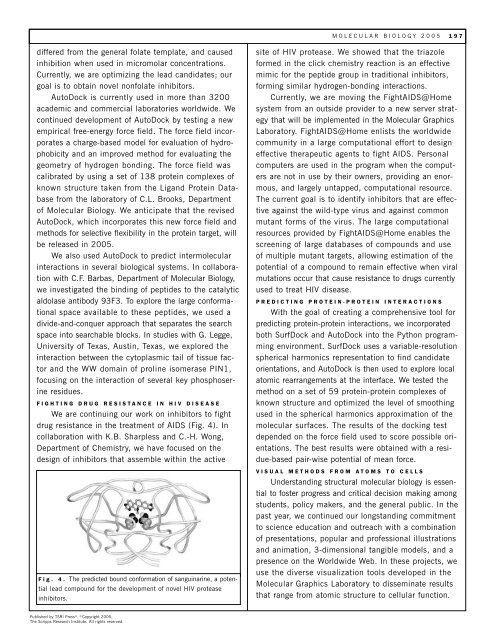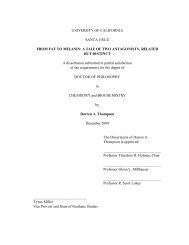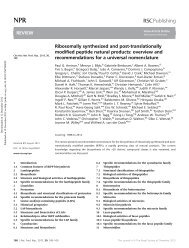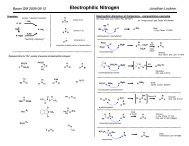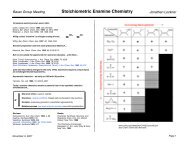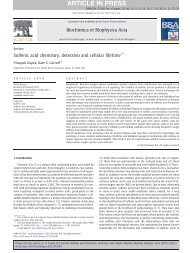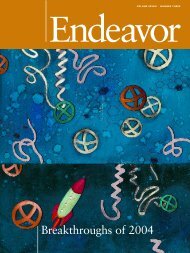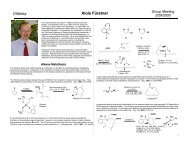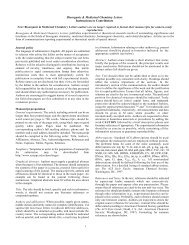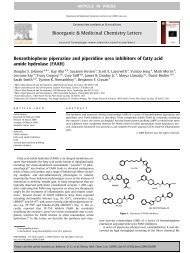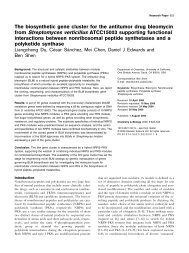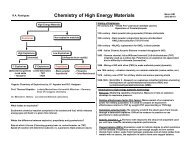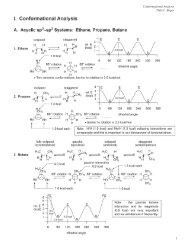Molecular Biology - The Scripps Research Institute
Molecular Biology - The Scripps Research Institute
Molecular Biology - The Scripps Research Institute
Create successful ePaper yourself
Turn your PDF publications into a flip-book with our unique Google optimized e-Paper software.
differed from the general folate template, and caused<br />
inhibition when used in micromolar concentrations.<br />
Currently, we are optimizing the lead candidates; our<br />
goal is to obtain novel nonfolate inhibitors.<br />
AutoDock is currently used in more than 3200<br />
academic and commercial laboratories worldwide. We<br />
continued development of AutoDock by testing a new<br />
empirical free-energy force field. <strong>The</strong> force field incorporates<br />
a charge-based model for evaluation of hydrophobicity<br />
and an improved method for evaluating the<br />
geometry of hydrogen bonding. <strong>The</strong> force field was<br />
calibrated by using a set of 138 protein complexes of<br />
known structure taken from the Ligand Protein Database<br />
from the laboratory of C.L. Brooks, Department<br />
of <strong>Molecular</strong> <strong>Biology</strong>. We anticipate that the revised<br />
AutoDock, which incorporates this new force field and<br />
methods for selective flexibility in the protein target, will<br />
be released in 2005.<br />
We also used AutoDock to predict intermolecular<br />
interactions in several biological systems. In collaboration<br />
with C.F. Barbas, Department of <strong>Molecular</strong> <strong>Biology</strong>,<br />
we investigated the binding of peptides to the catalytic<br />
aldolase antibody 93F3. To explore the large conformational<br />
space available to these peptides, we used a<br />
divide-and-conquer approach that separates the search<br />
space into searchable blocks. In studies with G. Legge,<br />
University of Texas, Austin, Texas, we explored the<br />
interaction between the cytoplasmic tail of tissue factor<br />
and the WW domain of proline isomerase PIN1,<br />
focusing on the interaction of several key phosphoserine<br />
residues.<br />
FIGHTING DRUG RESISTANCE IN HIV DISEASE<br />
We are continuing our work on inhibitors to fight<br />
drug resistance in the treatment of AIDS (Fig. 4). In<br />
collaboration with K.B. Sharpless and C.-H. Wong,<br />
Department of Chemistry, we have focused on the<br />
design of inhibitors that assemble within the active<br />
Fig. 4. <strong>The</strong> predicted bound conformation of sanguinarine, a potential<br />
lead compound for the development of novel HIV protease<br />
inhibitors.<br />
Published by TSRI Press ®. ©Copyright 2005,<br />
<strong>The</strong> <strong>Scripps</strong> <strong>Research</strong> <strong>Institute</strong>. All rights reserved.<br />
MOLECULAR BIOLOGY 2005 197<br />
site of HIV protease. We showed that the triazole<br />
formed in the click chemistry reaction is an effective<br />
mimic for the peptide group in traditional inhibitors,<br />
forming similar hydrogen-bonding interactions.<br />
Currently, we are moving the FightAIDS@Home<br />
system from an outside provider to a new server strategy<br />
that will be implemented in the <strong>Molecular</strong> Graphics<br />
Laboratory. FightAIDS@Home enlists the worldwide<br />
community in a large computational effort to design<br />
effective therapeutic agents to fight AIDS. Personal<br />
computers are used in the program when the computers<br />
are not in use by their owners, providing an enormous,<br />
and largely untapped, computational resource.<br />
<strong>The</strong> current goal is to identify inhibitors that are effective<br />
against the wild-type virus and against common<br />
mutant forms of the virus. <strong>The</strong> large computational<br />
resources provided by FightAIDS@Home enables the<br />
screening of large databases of compounds and use<br />
of multiple mutant targets, allowing estimation of the<br />
potential of a compound to remain effective when viral<br />
mutations occur that cause resistance to drugs currently<br />
used to treat HIV disease.<br />
PREDICTING PROTEIN-PROTEIN INTERACTIONS<br />
With the goal of creating a comprehensive tool for<br />
predicting protein-protein interactions, we incorporated<br />
both SurfDock and AutoDock into the Python programming<br />
environment. SurfDock uses a variable-resolution<br />
spherical harmonics representation to find candidate<br />
orientations, and AutoDock is then used to explore local<br />
atomic rearrangements at the interface. We tested the<br />
method on a set of 59 protein-protein complexes of<br />
known structure and optimized the level of smoothing<br />
used in the spherical harmonics approximation of the<br />
molecular surfaces. <strong>The</strong> results of the docking test<br />
depended on the force field used to score possible orientations.<br />
<strong>The</strong> best results were obtained with a residue-based<br />
pair-wise potential of mean force.<br />
VISUAL METHODS FROM ATOMS TO CELLS<br />
Understanding structural molecular biology is essential<br />
to foster progress and critical decision making among<br />
students, policy makers, and the general public. In the<br />
past year, we continued our longstanding commitment<br />
to science education and outreach with a combination<br />
of presentations, popular and professional illustrations<br />
and animation, 3-dimensional tangible models, and a<br />
presence on the Worldwide Web. In these projects, we<br />
use the diverse visualization tools developed in the<br />
<strong>Molecular</strong> Graphics Laboratory to disseminate results<br />
that range from atomic structure to cellular function.


